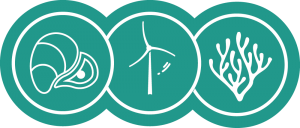Offshore wind, flat oyster aquaculture & restoration, & seaweed cultivation in Belgium
Where aquaculture feeds ecosystem restoration

KEY FACTS
Parkwind, a partner in UNITED, is one of Europe’s leading companies in offshore wind energy production. It operates 771 MW in the Belgian territorial waters across four wind farms and is involved in several private and public R&D projects ranging from energy storage to marine biology / environmental biology.
The Belgian pilot will be developed in an offshore wind farm, operated by Parkwind in Belgian territorial waters
Before 19 century oyster reefs used to be abundant and oysters were common source of protein for the locals.
The scour protection around wind turbine poles may encourage the formation of natural oyster reefs
Cross-fertilisation between oyster aquaculture and oyster reef restoration is expected to create synergy
Rise and fall of the European flat oyster
The European flat oyster (Ostrea edulis) is a luxury seafood, considered a more valuable and marketable product than the Pacific oyster (Crassostrea gigas). Indigenous to Europe, the flat oyster has been part of our diet for many centuries. Oyster spat – the young oysters – has been collected from rocks for grow-out in ponds since Roman times, and flat oyster aquaculture flourished in Europe in the 18th and 19thcenturies. However, overfishing since the 19th century and the occurrence of diseases (such as bonamiasis) in the 1980s devastated wild oyster reefs, and recent efforts to obtain cultivated spat have not been successful, with unexplained deaths of larvae and spat. With wild spat becoming rare, aquaculture of flat oyster is now impossible in most traditional rearing areas.
In Belgium, flat oysters used to be abundant and formed large oyster reefs, a valuable habitat supporting a unique marine biodiversity. What used to be a key element of the country’s biodiversity, cuisine and culture, is almost extinct today.
The challenge
Co-location of restoration and aquaculture in wind parks looks like a logical choice, but we are still far from its large-scale application. The distance from the coast complicates implementation, operation and maintenance of the structures needed for restoration and aquaculture production, and the same can be said about the harsh sea and weather conditions in the North Sea. Optimal growing conditions of flat oyster are quite specific, and this makes offshore aquaculture and restoration very challenging. The selected scour material must fulfill the technical requirements imposed on scour material in general and, at the same time, it should create an attractive habitat for oyster larvae to settle.

